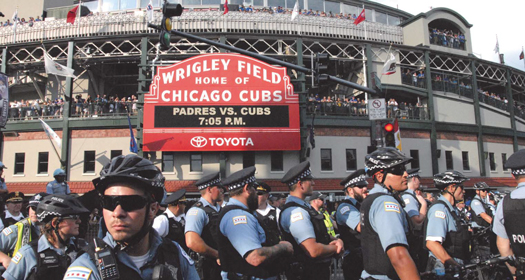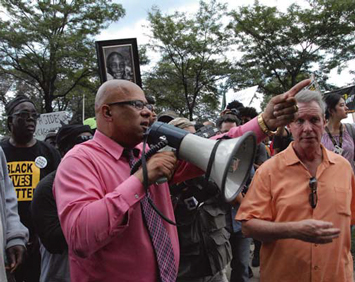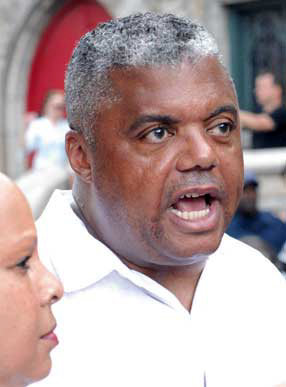Spreading the pain to Chicago’s White Side
By by Bryan Crawford -Contributing Writer- | Last updated: Aug 8, 2018 - 11:59:05 AMWhat's your opinion on this article?

Police form a barrier near Wrigleyville in North Chicago, home of the Chicago Cubs. Photos Haroon Rajaee
|
Activists say protest brought a taste of harsh reality to insulated neighborhoods
CHICAGO—While the turnout may have been smaller than the anti-government demonstration that shut down the Dan Ryan Expressway last month, the impact and attention that local activists, organizers, pastors and community residents, all of whom are upset and frustrated with violence plaguing the South and West Sides of Chicago, captured should not be understated.
For days, local news media reported on the planned march to shutdown Lake Shore Drive on Chicago’s North Side, which remains predominantly White and often sheltered from havoc suffered in the city’s Black neighborhoods.
The march was set for the height of rush hour, on the first day of the Lollapalooza music festival just a few miles away, and hours before the start of a Chicago Cubs game, angering many North Side residents and business owners in the Lakeview and Wrigleyville neighborhoods who would be affected.
But that was exactly the point.
Wrigleyville and Lakeview are 81 percent and 80 percent White respectively. The two neighborhoods sit along the shoreline of Lake Michigan and during the summer months, serve as playgrounds for Whites in the city and surrounding suburbs to come and enjoy the weather, activities and nightlife.

Tio Hardiman addresses crowd.
|
It’s not uncommon to see people riding bikes, pushing strollers and walking dogs in these communities, activities they can take for granted because they are insulated from the harsh realities and daily violence faced by those, who if only for a few hours, brought White residents face-to-face with the people who live in parts of the city they only hear about on the news.
“We wanted to redistribute the pain,” Tio Hardiman, community activist, former candidate for governor of Illinois, CEO of Violence Interrupters, and one of the principal organizers of the march, told The Final Call. “I feel really good about what we did. Our message was heard. It was peaceful. There were no arrests. We let the people on the North Side know that we are tired of being at the bottom of the totem pole and we need some of the same resources to help turn our communities around.”
Unfortunately, but not surprisingly, protestors were met with antagonism from residents who seemed annoyed at their presence Aug. 2 which disrupted daily routines.
In one confrontation, an older White man faced off with Black protestors, accusing them of being disrespectful to police officers who were present, calling them “instigators” and patronizing them, saying, “behave yourself and act civil.” In another incident, a White man told protestors to “get a job.”
It was expected animosity that Eric Russell, another community activist and march organizer, said had been going on all week.
Mr. Russell told The Final Call that he reached out to the Nation of Islam’s Justice Or Else! Local Organizing Committee after receiving six death threats. Many of the threats came via social media, he said, as well as from a variety of different people, including former police officers and an irate soccer mom.
“She called me and said, ‘N—er, why don’t you march your Black a— on 79th Street? If I’m five minutes late picking up my daughter, you’re going to owe me $50 because I’m going to be assessed a few. You Black people know nothing about family responsibility and you all should work on teaching your kids to be law abiding, instead of coming up here disrupting traffic,’ ” said Mr. Russell, recounting the call. “That’s exactly what she said to me.”
Between Lake Shore Drive where the march started, to the outside of Wrigley Field where it ended, harsh words were exchanged as protestors used chalk to scrawl statements such as, “Enough is enough,” and “16 shots by killer cops,” a reference to the killing of Laquan McDonald by Chicago Police Officer Jason Van Dyke, whose trial begins in September. Wrigley Field is home to the Chicago Cubs baseball team, which had a game the day of the protest.
All of this underscored the true mission of the protest and march, which was to call for the resignation of Mayor Rahm Emanuel and Chicago Police superintendent Eddie Johnson.
“It’s hard to talk about violence and ignore the corrupt tree that produces this violence,” Rev. Livingston said. “Violence is not impersonal. The people who get killed or hurt in this city, all have names. This means corruption is not impersonal as well, meaning there are people involved in creating a culture of political and socioeconomic corruption in Chicago. … Frederick Douglass said, ‘Power concedes nothing without a demand.’ In the Bible, Moses didn’t negotiate, he made a demand of Pharaoh: Let my people go. Pharaoh and Moses can’t walk together because they have different agendas. Rahm Emanuel and Eddie Johnson didn’t create the corruption, but they can’t be allowed to keep perpetuating it.”
While local media reported that approximately 200 people showed up to protest, organizers say the actual number was closer to 500. The underestimating of crowd size, especially where Black demonstrations are concerned is certainly nothing new. The Million Man March organized by Min. Louis Farrakhan, was said to have been attended by 400,000 people by the United States Park Police, when the actual number was 1.5 to 2 million people.
“They do that on purpose,” one protestor said. “Allegedly, that 200 number came from the police department, and we know the police are part of the problem. Police patrol Black communities like they’re the judge, jury and executioner, and then they put out numbers that fits their narratives of being successful in community policing by making it seem like it wasn’t that many people who were upset about what’s happening around them, and that things aren’t as bad as they seem.”

Rev. Gregory Livingston
|
Aside from the friction from community residents and what appears to be a downplaying of the demonstrations impact by police, Rev. Livingston wants the insulated residents of the Lakeview, Wrigleyville and White communities across Chicago to know the problem of violence affects everyone who lives in this city.
“The people in those communities, typically have never had to live on the rough side of the mountain. They weren’t raised inside of the raw situations that many Black people are,” Rev. Livingston explained. “If they were, then they would understand why we need to break down these walls of segregation and do something by coming together as a city. Chicago is a body, and if a part of your body becomes diseased and you choose to ignore or neglect it, the rest of your body will be affected. You can’t ignore one thing and then expect everything else to go on as usual.”
INSIDE STORIES AND REVIEWS
-
-
About Harriett ... and the Negro Hollywood Road Show
By Rabiah Muhammad, Guest Columnist » Full Story -
Skepticism greets Jay-Z, NFL talk of inspiring change
By Bryan 18X Crawford and Richard B. Muhammad The Final Call Newspaper @TheFinalCall » Full Story -
The painful problem of Black girls and suicide
By Charlene Muhammad -National Correspondent- » Full Story -
Exploitation of Innocence - Report: Perceptions, policies hurting Black girls
By Charlene Muhammad -National Correspondent- » Full Story -
Big Ballin: Big ideas fuel a father’s Big Baller Brand and brash business sense
By Bryan Crawford -Contributing Writer- » Full Story






 Click Here Stay Connected!
Click Here Stay Connected!








